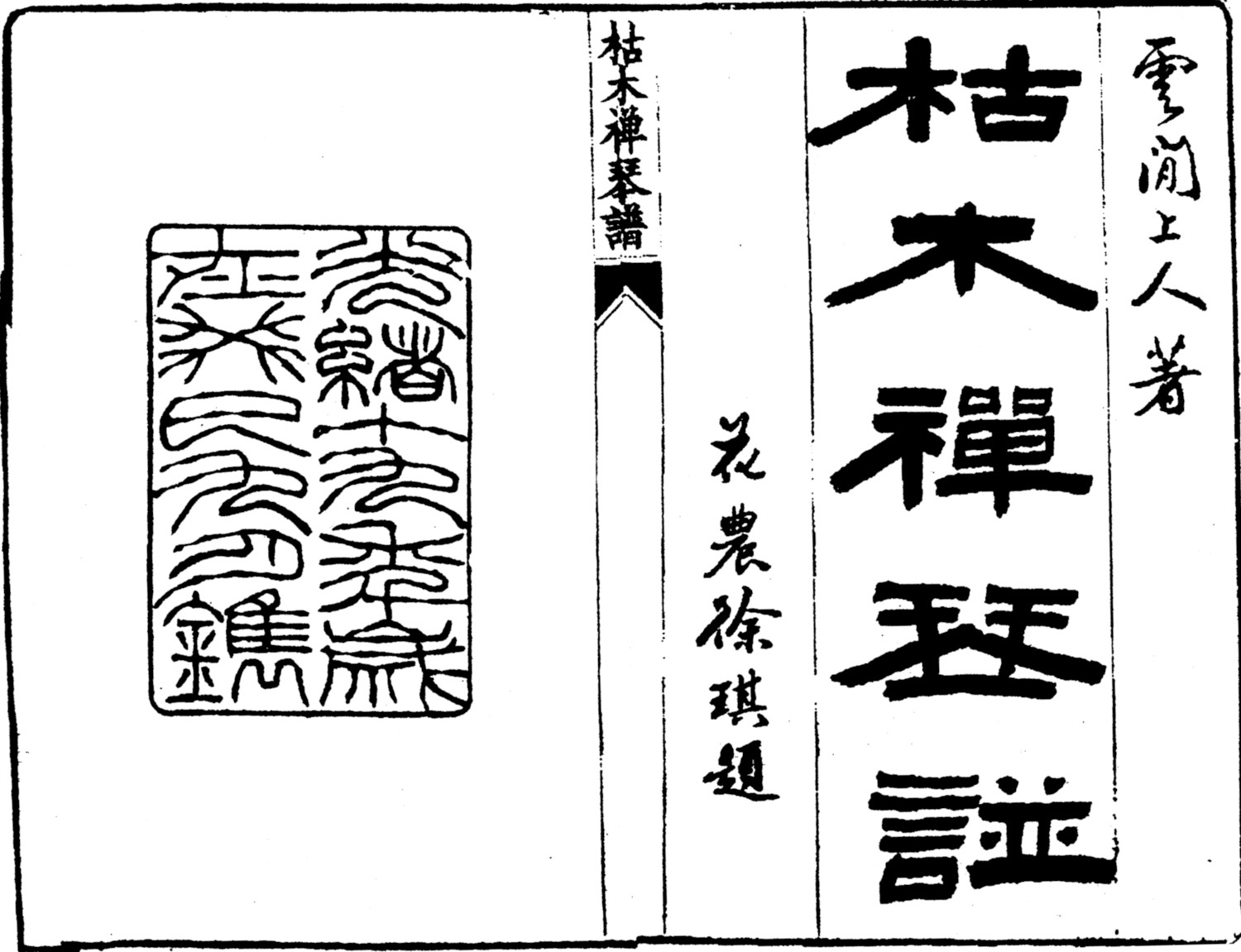|
T of C
Home |
My Work |
Hand- books |
Qin as Object |
Qin in Art |
Poetry / Song |
Hear, Watch |
Play Qin |
Analysis | History |
Ideo- logy |
Miscel- lanea |
More Info |
Personal | email me search me |
| In handbook List / ToC ZFX preface / Buddhism and the Qin Heart Sutra: Se Kong Jue | 首頁 |
|
Kumuchan Qinpu
Withered Timber Zen (Monk's) Qin Handbook 1 Compiled by Shi Kongchen 2 |
枯木禪琴譜
釋空塵; QQJC XXVIII 1-144; 1893 Opening page (QQJC XXVIII/1)3 |

This handbook has eight folios and 32 melodies. Its title could also be translated as Dead Wood Qin Handbook in accordance with the idea that when a tree is cut down it dies, but when it produces music it comes back to life. The handbook was compiled by the Buddhist monk 釋空塵 Shi Kongchen ("Buddhist Monk of Emptiness while in the Dust of the World"; 1839-1913), monk name 雲閒 Yun Xian, pen name Kumuchan.
According to the preface by "Yunxian" himself, he began studying the qin while very young, his first named teacher being the monk Mucun4 at their monastery near Nantong. This being near Yangzhou it is assumed this meant he learned Guangling Style of qin, but later he studied with a number of other players all over China, in particular Zhao Yifeng,5 Ding Suian6 and Qiao Ziheng.7
Although most of the melodies in this handbook are related to melodies in earlier handbooks, Shi Kongchen does say in his explanations that he used the Wuzhizhai and Ziyuantang handbooks as models, though it is not clear exactly how the versions here may have been changed. And as for melodies Shi Kongchen himself created, these seem to consist of the first six of the seven melodies in the last folio. Only a few of the melodies in the handbook have overtly Buddhist themes.8
To my knowledge only two of Shi Kongchen's own melodies are available on recording:
- 枯木吟 Kumu Yin
Recording by Tony Wheeler on his album Plain Silk Qin - 那羅法曲 Naluo Fa Qu
Recording by 余青欣 Yu Qingxin (BiliBili; YouTube)
Further details about this handbook will be added later. Meanwhile there is further information in Zha Fuxi's Preface and with the handbook's Table of Contents.
Footnotes (Shorthand references are explained on a
separate page)
1.
Kumuchan Qinpu 枯木禪琴譜 (only the 2010 QQJC XXVIII, pp. 1-144)
Zha Fuxi's preface in the QQJC edition says that the handbook has 8 folios, and these eight are clearly marked in the original handbook as copied into QQJC, but for some reason QQJC edition Table of Contents outlines them as 4 folios. This book is also available as a facsimile reprint
(ZGSD). Perhaps there it has four juan, each with two of the original juan.
(Return)
2.
Shi Kongchen 釋空塵 (1839-1913)
Shi Kongchen ("Buddhist Monk of Emptiness amidst the Dust of the World") had the monk name 雲閒 Yun Xian ("Clouds: Leisure", with all the extra meaning that comes by juxtaposing the two words), but he also used the pen name Kumuchan (Withered Timber [Chan or Zen] Monk). As yet I have not been able to find his birth place or birth name: in the handbook he is referred to as 古吳釋空塵雲閒 from "古吳 old Wu", sometimes interpreted as 吳縣 Wu Prefecture, i.e., Suzhou, but this is not clear. Apparently he was orphaned while young and perhaps began as a teacher, but around the age of reaching adulthood he entered the monastic path and began studying qin with the monk Mucun at the Bodhi Monastery in Rugao (near Nantong).
Because of Nantong's proximity to Yangzhou it has been assumed that Mucun was trained in the Guangling qin style, and he does refer to qin handbooks said to reflect Guangling style but, as described in the preface here, he also traveled and studied widely.
(Return)
3.
Image: Opening pages of Kumuchan Qinpu
(expand)
See QQJC XXVIII/3.
(Return)
4.
牧村 Mucun (from Rugao, near Nantong)
There is detailed information about Mucun in an article by 嚴曉星 Yan Xiaoxing entitled 《清末琴僧牧村史料鈎沈》 (Unearthing Historical Materials on the Late Qing Dynasty Guqin Monk Mucun). It was initially published in the 2017 third issue of the 湖南科技學院學報 Journal of Hunan University of Science and Technology. Found online at www.360doc.com. The article traces how Mucun had a student named Jielian (洁下蓮) who in turn had several students who went on to be of some importance, including one who founded the 中國佛教歷史博物館 Museum of the History of Buddhism in China in Beijing.
(Return)
5.
趙逸峰 Zhao Yifeng
NFI as yet.
(Return)
6.
丁綏安 Ding Suian (from Wucheng in Zhejiang)
NFI as yet.
(Return)
7.
喬子衡 Qiao Ziheng (from Huaishan in Anhui)
For further information on Qiao Ziheng see
嚴曉星《「淮陽琴派」史料再考察》2013年第1期,後收入《南京藝術學院學報·音樂與表演版》2013年第1期,後收入嚴曉星著:《七弦古意:古琴歷史與文獻叢考》,北京:
故宮出版社,2013年11月。
Yan Xiaoxing, "Huayang Qin School, a Re-examination of Historical Materials ", Journal of Nanjing University of the Arts: Music and Performance Edition, 2013/1. Later included in Yan Xiaoxing, Seven-String Antiquity: Studies on the History and Texts of the Guqin, Beijing: Palace Museum Press, Nov. 2013.
(Return)
8.
Buddhist themes
The titles of some melodies in the last folio in particular may not be overtly Buddhist, but I have not yet examined all the lyrics.
(Return)
Return to the annotated handbook list or to the Guqin ToC.